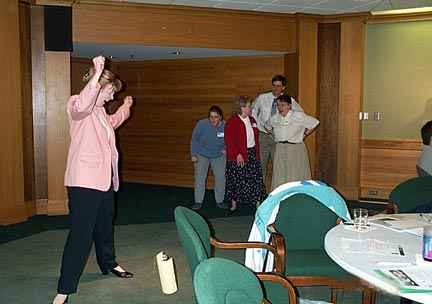 |
|
 |
Why is it fun to drop things? To launch the exploration, the teacher facilitates a discussion about falling objects, demonstrating that even when thrown horizontally an object is observed to ‘fall’ to the Earth. Picture #1 shows the path of a falling cannonball shot horizontally from the top of a ridiculously high mountain. If it could be shot horizontally very fast, say at 18,000 mph, then the object will fall around the Earth as in Picture #3 and come back to you (get off the mountain). But this is an orbit! The Space Shuttle—and the astronauts inside—is falling around the Earth. And they’re doing it BECAUSE of gravity. Students then decide, with creative facilitation by the teacher, that they could build a model of a shuttle with an astronaut inside, drop it, and see if they see evidence of weightlessness. So they christen a soda bottle as a model of a Space Shuttle. The bottle’s labels are removed to be able to see inside, and a piece of paper with a thick black horizontal line is wrapped and taped around half the bottle with the line facing the inside of the bottle. Looking into the bottle you can see the line at the back. It’s a good reference line to watch as the bottle is dropped. A little paper astronaut is then suspended by a slender thread inside the bottle so her feet are at the black line. The person that will be dropping the bottle is holding bottle and thread, and releases both at the same time. The bottle is then free to fall to the ground, and the astronaut is also free to fall inside the bottle. The teacher in the picture has just dropped bottle and astronaut, and the rest of her team watched as it fell. They noticed that the astronaut’s feet never moved from the line. As the bottle was falling, she remained motionless relative to the bottle. She simply floated in the center of the bottle all the way down. She was seemingly weightless. Why? Because bottle and astronaut were both falling, so she never got closer to the bottom of the bottle. ‘Weightlessness’ is what an object experiences when it is falling! It is a simple experiment that leads to deep conceptual understanding, and invalidates a fundamental misconception that people carry throughout their entire lives. How many adults could benefit from this experience? |